A Life of Dharma
by: Nikunja Vilasini Devi Dasi
In memory of His Holiness Krishna Dasa Swami, whose life and passing exemplify his words: “Live for dharma, die for dharma; live for Krishna, die for Krishna.”
Forty-one-year-old Krishna Dasa was already feeling elated as he stood in the crowd waiting to catch a glimpse of Srila Prabhupada. It was July 7, 1973. On the order of his spiritual master, Srila Trilocanadeva Maharaja, Krishna Dasa had come to England from India in 1966 to propagate sanatana-dharma, the eternal religion of the soul’s relationship of loving devotion with the Supreme Lord. He had felt alone in his quest to follow the order of his guru. A foreign culture had required a different kind of austerity than had his simple village life in Punjab. He had spoken about sanatana-dharma on radio shows and to the Indian community in various venues in London. Now he wondered how the culture and philosophy he had been trying to propagate had miraculously taken form in the dazzling chariot parade before him. He watched from a distance as the chariots maneuvered through Hyde Park towards Trafalgar Square, surrounded by curious Londoners and dancing devotees of Lord Jagannatha.
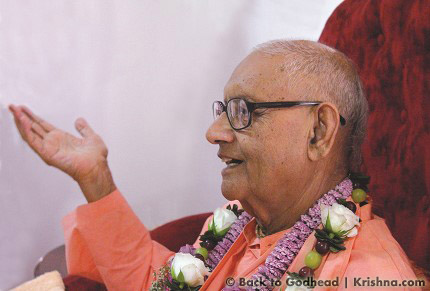
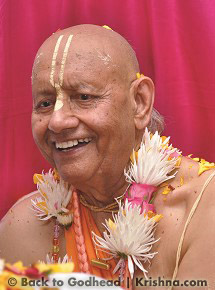
Krishna Dasa had met these disciples of Srila Prabhupada seven months before. How could he forget the knock on his door in November 1972 that had brought him bliss and the hope that sanatana-dharma would be reestablished in the world? It was hard to believe that the young orange-robed Vaishnava monk who had come to his door was an Englishman and that there were many more like him. Krishna Dasa had heard about how Srila Prabhupada, the person he was anxiously waiting to see, had brought Chaitanya Mahaprabhu’s message to the West, how he had opened temples of Lord Krishna in America and other parts of the world, how he had spread the glories of the Bhagavad-gita and other Vaishnava scriptures without discrimination, and how he had won the hearts of these young English boys and girls who had left everything to help him spread his mission.
Krishna Dasa saw Srila Prabhupada emerge like a golden light from the crowd. Prabhupada’s jubilant dancing throughout the parade captivated him. How was it that there were no signs of fatigue in Srila Prabhupada’s frail, sick body? The young devotees could not even keep up with him. Krishna Dasa was then convinced that Srila Prabhupada could not be ordinary.
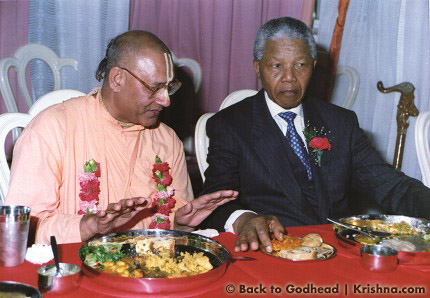
Meeting Srila Prabhupada
Days passed, and Krishna Dasa’s mind was bursting with thoughts of Srila Prabhupada and how to meet him. He rushed to Srila Prabhupada’s door at Bhaktivedanta Manor only to be turned away by two strict disciple-guards.
“You look as if you are the guards at the doors of Vaikuntha. Are you Jaya and Vijaya?” teased Krishna Dasa, referring to a story in Srimad-Bhagavatam. “But you are very fortunate that I am not one of the Kumaras. I won’t curse you!”
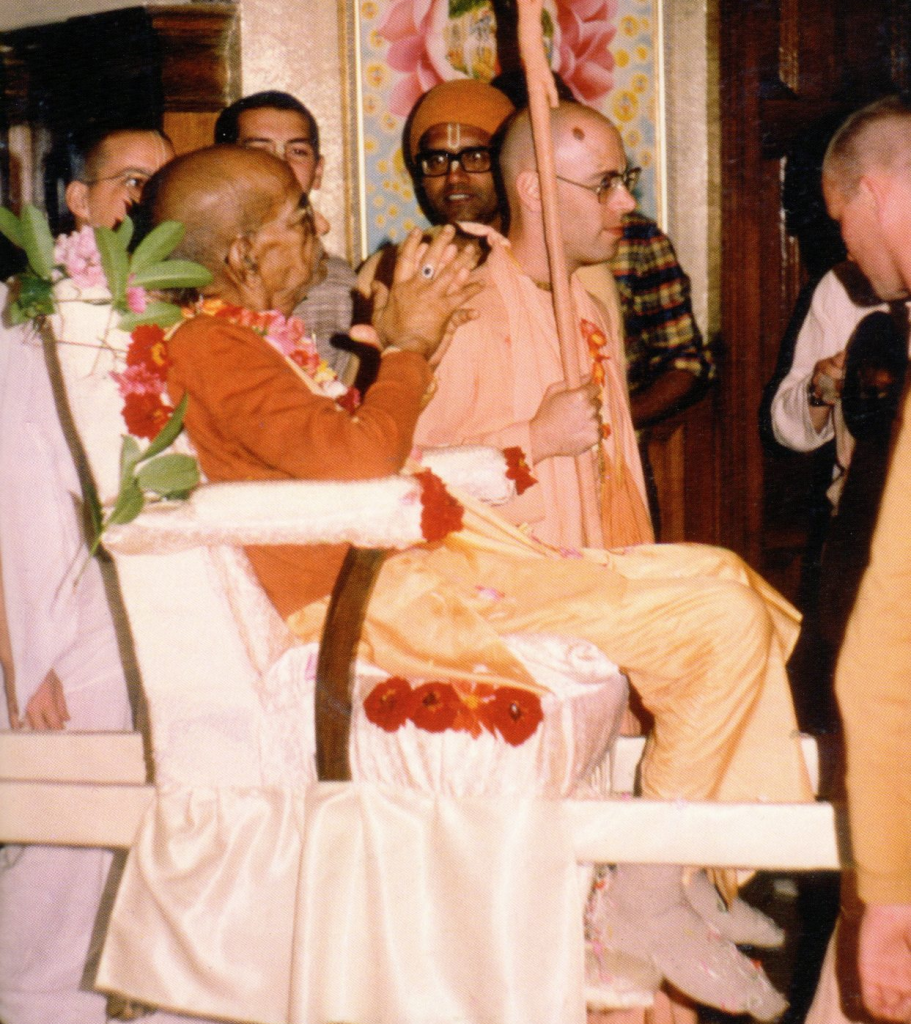
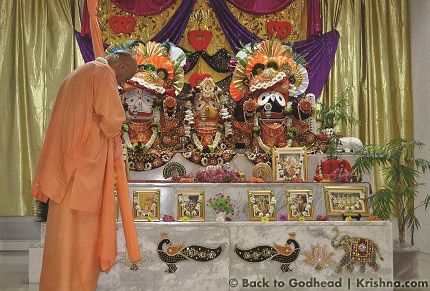
Feeling dejected and heartbroken, Krishna Dasa wrote a letter to Srila Prabhupada telling him how he had come to meet the devotees, how he had been giving classes at the Bury Place temple, how he had seen Srila Prabhupada dance at Rathayatra, and how since he had read the Guardian’s front-page headlines “Challenge to Nelson,” which glorified the Rathayatra festival, his desire to meet Srila Prabhupada was increasing.
Srila Prabhupada wrote back and humbly apologized for his disciples’ behavior, welcoming him to visit him at any time. Krishna Dasa eagerly returned to Srila Prabhupada’s door only to again be confronted by guards. This time Srila Prabhupada himself intervened and invited him into his room.
Krishna Dasa did not know that meeting Srila Prabhupada face to face would alter his life forever. Referring to the places of his and Srila Prabhupada’s birth, he said, “Srila Prabhupada, as you are uniting the East and the West of this world, I think our meeting is between the east and west of Bharata.” When Srila Prabhupada heard about Krishna Dasa’s life and activities to propagate God consciousness and his desire to revive Bharata’s glorious spiritual heritage, his face lit up. Krishna Dasa told of how as a young boy he had been trained by his maternal grandfather in Vaishnava culture and traditions. When he was only eleven years old, he had learned the Ramayana, and by the time he was initiated at the age of seventeen, he had memorized the Bhagavad-gita and then studied Srimad-Bhagavatam and other Puranas. Even while working as a schoolteacher and headmaster in Punjab, he had tried to spread the message of these great Vedic literatures.
Prabhupada was silent and then said, “Join this movement and preach!”
Srila Prabhupada’s penetrating gaze and serious expression caused Krishna Dasa’s heart to leap. He had come only to offer his respects and to congratulate Srila Prabhupada for his achievements, but now he felt challenged.
“But I am already initiated and preaching,” Krishna Dasa replied. “I have been brought up as a missionary of sanatana-dharma, so how can I join you and give that up?”
“We are both preaching sanatana-dharma,” Srila Prabhupada answered, “and we both belong to the Brahma sampradaya, so why are we doing this separately? Here you will have all facility to preach. You simply come and join us.”
“But how can I give up my Guru Maharaja?” Krishna Dasa exclaimed.
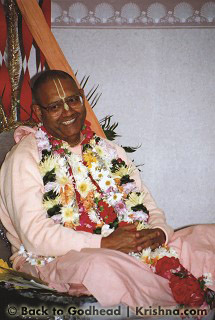
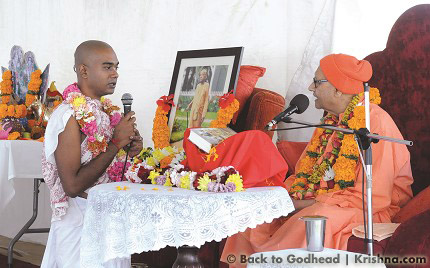
“When did I ask you to do that? Can a Vaishnava ask another Vaishnava to give up his Vaishnava guru? I only asked you to please join me in spreading sanatana-dharma, which you are already doing.”
Krishna Dasa was drawn to this dynamic personality. He surrendered to Srila Prabhupada’s request.
A serious discussion followed, and eventually Srila Prabhupada suggested that Krishna Dasa leave his family and other responsibilities, and in time he would give him sannyasa initiation.
As Krishna Dasa was leaving, he said to Srila Prabhupada, “I accept you as my sannyasa guru.”
“I accept you as my sannyasa disciple,” Srila Prabhupada replied.
Krishna Dasa reminded Srila Prabhupada that he would need to seek permission from his diksha guru. Srila Prabhupada agreed and asked him to write to his guru straight away.

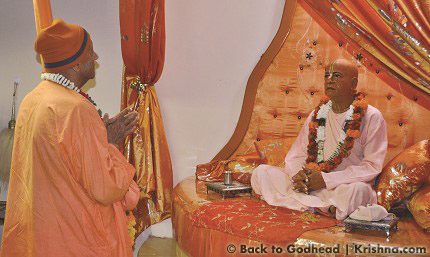
Krishna Dasa felt that he had come as a householder with a different intention but was leaving as a sannyasi ready to give his life to his new guru.
He later recalled, “In 1966, one year after Prabhupada left for the United States, I left for the UK as a missionary of sanatana-dharma and did not know about Srila Prabhupada’s activities.”
He said that he marveled at how the Lord wonderfully makes arrangements to fulfill His desire. He knew that his meeting with Srila Prabhupada was not by chance; it was part of a divine plan.
Krishna Dasa received permission from his guru, who supported his joining Srila Prabhupada. With the combined blessings of two powerful souls, Krishna Dasa felt ready to execute their mission with renewed zeal. He quickly arranged for his family’s care and moved into the Bury Place temple in April 1974. What followed was four decades of selfless service.
Sacrifice and Surrender
“We had a queuing system for the shower in the brahmacari ashram, and there were about fifty of us, but he patiently waited his turn with the other, much younger men,” writes Bhakti Chaitanya Swami.
Vicitravirya Dasa, the temple president, would tell us how Krishna Dasa would sometimes preach very strongly to the Indian people around London and insist they become life members and donors. I saw him in action during festivals at Bhaktivedanta Manor. He was like a transcendental lion, roaring at the people and powerfully arousing their sense of responsibility as people from Indian backgrounds. He glorified Srila Prabhupada very nicely, sometimes referring to him as the thirteenth mahajana, and would tell the people that Prabhupada was the real representative of their culture and tradition. . . .
His older family members in Punjab were deeply disturbed that he had left his family and joined ISKCON full time, and Krishna Dasa was to meet them and try to make amends and pacify them. Vicitravirya went with him, and later told us that it had been a hair-raising experience. The family had tried to force Krishna Dasa to go back to his wife and children in London, but Krishna Dasa would not hear of it at all. They then wanted to physically attack Krishna Dasa, but somehow he and Vicitravirya managed to escape.
This greatly impressed us. We were all from hippie-type backgrounds, and leaving our families had been no problem for us, but here we saw someone from a completely different social environment, a cultured person who had been brought up as a devotee. And when he had been put under severe pressure to give up his dedication to Lord Krishna, he had adamantly refused. His resolve in Krishna consciousness struck us deeply.
Akhandadhi Dasa recalls:
When Krishna Dasa joined, it was a huge thing for us to have a senior Indian devotee living with us who had the skill of rhetoric and oration, the depth of knowledge, and the absolute fire for preaching. It must have been very hard for him living among Westerners who didn’t share the same background and culture of Vaishnava behavior, manners, and tendencies. But I never saw any sort of frustration or disappointment in him. He was always encouraging and supportive and established us in a way that the rest of our preaching efforts could never have done.
Shivarama Swami remembers:
Krishna Dasa Swami was extraordinary; he was a “Prabhupada man.” He bravely left everything to follow Srila Prabhupada’s request, often preaching in austere circumstances.
He was learned in many aspects of shastra and philosophy and knew the life and philosophy of prominent spiritual leaders and saints. Once he related to me the entire life and philosophy of Shankaracharya and recalled how when he was only six years old, he had learned Shankaracharya’s Bhaja Govindam prayers while hearing his grandfather reciting them during his bath.
Srila Prabhupada’s Punjabi Tiger
After Maharaja’s initial adventures in England, he traveled to various continents, spreading Krishna’s message. Thousands of people were attracted to his dynamic presentation of eternal truths and were inspired by his uncompromising standards of spiritual discipline and practice. Many came forward to take his shelter and guidance, and in 1987 he became an initiating spiritual master. Giriraja Swami, the GBC for Mauritius and South Africa then, saw a need for a spiritual figure of Maharaja’s stature to grace the African continent and stabilize the Mauritian and South African centers during a turbulent time. Sure enough, Krishna Dasa Swami succeeded in winning the hearts of many people who later became his disciples.
Poor health and a quadruple bypass heart surgery did not discourage Krishna Dasa Swami’s efforts. He continued to travel and speak strongly against the hypocrisies and sins of Kali-yuga, many times singling out treacherous leaders and politicians.
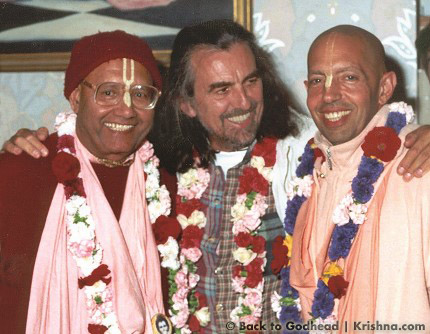
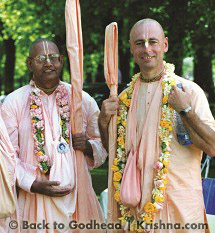
B. B. Govinda Swami affectionately called him “Srila Prabhupada’s Punjabi Tiger” because he was impressed by Maharaja’s powerful preaching spirit, staunch spiritual ideals, and ability to instill God consciousness in people from all parts of the world. Maharaja inspired the opening of temples in South Africa and Botswana. He persuaded the local city councilors in Mauritius to rename streets Vrindavan Road and Hare Krishna Road. The rural village of Beau Bois became Vrindavan.
Back in England, he visited the mosque of the Ahmaddiya Muslim community and addressed the members with familiar Urdu phrases, presenting Krishna consciousness with parallels from the Koran. They were impressed with his knowledge of other world religions and languages. Wherever he went, he struck people with his fearlessness and straightforwardness. He wouldn’t compromise just to please. But his words exuded compassion – and that was how people grew to love him.
Embodiment of Compassion
“Your stomach is a graveyard and your fridge is a mortuary,” he would remind those who were nonvegetarians. His description of meat-eating would inspire many in his audiences to become vegetarians overnight. He did not make people feel guilty or deride their behavior, but he made them understand that to grasp the intricacies of spiritual knowledge and the spiritual way of life, one has to come to the human platform of goodness, compassion, and concern for other living beings. He understood that human society would have to suffer the consequences of cruel actions, and he feared for its welfare.
His compassion for animals, especially the cow, was evident in the goshala he developed in his hometown in Punjab. His ashram, in an idyllic rural setting, houses more than seventy cows. It became known as Mahadhama (great abode), because the greatness of a place can be ascertained by how well its people take care of its animals. Mahadhama, or Kalkidhama, as some would call it, became a sanctuary for disciples and followers, and there he installed deities of Gaura-Nitai, Gopala, and Lord Kalki, the future incarnation for Kali-yuga. He took refuge in the fact that the Lord would come again to establish the principles of religion and save His devotees from Kali’s fierce grip. Until the Lord’s advent, he firmly believed that cow protection would grant prosperity and harmony to human society and that eternal spiritual values can be achieved through devotion and surrender to Krishna.
Emissary of the Bhagavad-gita
Krishna Dasa Swami’s devotion was seen during the annual Maha Gita-yajna festival, which he inaugurated in South Africa. Around 150 devotees from all over the province would come to recite the verses of the Bhagavad-gita while offering oblations into the fire. For at least ten hours on a scorching summer day, usually on Christmas Day, Maharaja would recite and extol the glories of the Bhagavad-gita with the vigor of a young man. He trained his disciples in every aspect of the auspicious event – organization, yajna arrangements, proper Sanskrit pronunciation of the shlokas, meticulous priestly conduct, and etiquette. He said he wanted the devotees to perform some kind of austerity so that their hearts would become purified and thus they would experience the bliss of full immersion in Krishna. And this is what happened. Anyone who attended these yajnas would describe it as one of the most memorable times in their lives, for they had experienced the potency of the Bhagavad-gita’s divine presence and message.
A Glorious Passing
Maharaja’s aphorism “Live for dharma, die for dharma; live for Krishna, die for Krishna” resonates with all those who heard him speak. After living his life by this aphorism, at the age of 84 he left this world like a general on dharma-kshetra, the battlefield of dharma. In the twilight of his life, he had transcended bodily pain and discomfort, including a severe heart condition, to travel and inspire his disciples in England, Mauritius, and especially South Africa.
He would tell them, “If you remember Krishna, you are healthy.”
Quoting a Hindi maxim, he would say, “With a rock, crush the forehead of that happiness which causes the remembrance of the holy name to disappear from your heart. Be grateful to the suffering that forces you to surrender and chant the holy name at every moment.”
His words were tested. In December 2015, on the day of the twenty-first Gita-yajna in South Africa, the last he would attend, Maharaja’s health was precarious. He could barely walk or speak, so no one expected him to attend. But there he was, on the vyasasana – taking on new life, speaking like he’d never spoken before, and completing all seven hundred verses of the Bhagavad-gita with wonderful explanations.
Months later, back in India, his devoted disciples rushed him to a New Delhi hospital only to find out that his end was near. On July 21, 2016, they decided to take him to Vrindavan, the most auspicious place to leave this world. The journey was challenging and risky, but as they reached the outer precincts of Vraja, Maharaja breathed his last while hearing the holy names in perfect Krishna consciousness.
Devotees from all over the world gathered in Vrindavan for his cremation and memorial service. Some witnessed the cows gathering to lick Maharaja’s feet before he was taken on procession to the Yamuna. A few disciples, who waited till the last minute of the cremation, witnessed a colorful rainbow of sparks spurting up from the center of the funeral pyre and lighting the sky – an indication to them that their guru had returned to the spiritual world.
Leaving a Legacy
Krishna Dasa Swami’s disciples realized they now had a tremendous responsibility – to carry the torch of dharma their guru had passed on to them. Therefore, they strive to carry on aspects of his glory: observance of Vedic culture and conduct, affectionate and compassionate dealings with others, strict adherence to Vedic principles, loyalty to Srila Prabhupada and his mission, and absorption in devotional service. This proves Srila Bhaktivinoda Thakura’s words true: “He reasons ill who tells that Vaishnavas die, when thou art living still in sound. The Vaishnavas die to live, and living try to spread the holy name around.” Krishna Dasa Swami’s legacy lives on.
Nikunja Vilasini Devi Dasi (Nirvana Kasopersad) is a disciple of Giriraja Swami and lives in Durban, South Africa, with her husband and two children. She works as a freelance writer and editor. She thanks the devotees who submitted photos for the article and the following devotees for interviews and help: Akhandadhi Dasa, Nabhinandana Dasa, Atri Rishi Dasa, Anasuya Devi Dasi, Priyavrata Dasa, Devaki Devi Dasi, Vasudeva Dasa, Radha Mohana Dasa, Ananga Manjari Devi Dasi, and Yamuna Devi Dasi.
A special thanks to His Holiness Giriraja Swami and Kalachandji Dasa for helping with the initial editing and for their support and encouragement.
